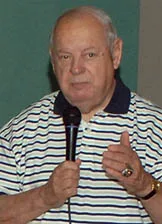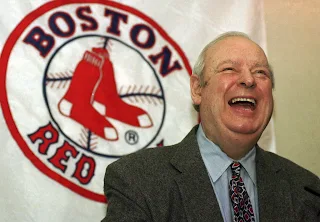 James Gerald "Lou" Gorman was an American baseball executive, and the former general manager of the Boston Red Sox and Seattle Mariners of Major League Baseball died he was , 82. He spent more than three decades in baseball operations, as a general manager, assistant GM, farm system director or scouting director, and at the time of his death he was the Red Sox' executive consultant for public affairs with an emphasis on community projects. He also was the coordinator of the Boston Red Sox Hall of Fame, to which he was inducted in 2002. He was inducted in the Kinston Professional Baseball Hall of Fame in 1985.
James Gerald "Lou" Gorman was an American baseball executive, and the former general manager of the Boston Red Sox and Seattle Mariners of Major League Baseball died he was , 82. He spent more than three decades in baseball operations, as a general manager, assistant GM, farm system director or scouting director, and at the time of his death he was the Red Sox' executive consultant for public affairs with an emphasis on community projects. He also was the coordinator of the Boston Red Sox Hall of Fame, to which he was inducted in 2002. He was inducted in the Kinston Professional Baseball Hall of Fame in 1985.(February 18, 1929 – April 1, 2011) |
 Career with the Orioles, Royals, Mariners and Mets
Career with the Orioles, Royals, Mariners and Mets
A native of South Providence, Rhode Island, Gorman grew up a Red Sox fan. At the high school level, at La Salle Academy, Providence, he was an excellent athlete, but was cut from the minors. His Baseball Reference player page records that Gorman played in 16 games for the 1948 Providence Grays of the Class B New England League, compiling a batting average of .036.[3] After his professional playing career stalled, Gorman enrolled in Stonehill College for his bachelor's degree and Bridgewater State College for his master's. Then he joined the United States Navy, where he served more than eight years of active duty, including two tours in Korea, and 34 years in all including his tenure with the United States Navy Reserve. He retired with the rank of captain.[4]Gorman resumed his baseball career in 1961 with the San Francisco Giants as general manager of one of their farm teams, before joining the Baltimore Orioles organization in 1964 as assistant farm director. He was promoted to director of player development in 1966, when the Orioles won their first World Series championship. In 1968, Gorman became the first farm system director in the history of the Kansas City Royals, where he eventually also assumed control of the team's scouting department. For his efforts, he was promoted to vice president in 1973 and assistant general manager in 1976.
But he soon departed for a new expansion team when he was appointed the first-ever general manager of the Seattle Mariners when they entered the American League in 1977. Although the under-capitalized Mariners struggled during Gorman's four seasons in Seattle, he obtained early Mariner standout Ruppert Jones in the 1976 Major League Baseball expansion draft (from his old Royals' organization) and drafted centerfielder Dave Henderson with his first-ever No. 1 choice in the June 1977 Major League Baseball draft.[5]
After building the Seattle organization from scratch, he returned to the East Coast as vice president, player personnel, of the New York Mets in 1980. Working under Mets' GM Frank Cashen, with whom Gorman served with the Orioles, he helped lay the foundation for the Mets' 1986 World Series championship — achieved at the expense of his next team, the Red Sox.
GM of the Red Sox
In the months preceding the 1984 season, the Red Sox were embroiled in a legal dispute involving two ownership factions seeking control of the team. Gorman was named a vice president of baseball operations in the Boston front office in January 1984; then, five months later, when the legal case was settled, he was officially appointed vice president and general manager, succeeding co-owner Haywood Sullivan, who moved up to chief executive officer.[6] When Gorman took on the GM job, the Red Sox already had players like Roger Clemens, Wade Boggs, Dwight Evans and Bob Stanley, stars that would form the nucleus of the talented Red Sox teams of the late 1980s. However, it was Gorman's acquisitions (from the Mariners) of Dave Henderson and Spike Owen that helped lead the Red Sox to the 1986 World Series.Though the team made it back to the playoffs in 1988 and 1990, it never got any closer to a championship than it had in 1986. Gorman made several key trades, such as picking up Nick Esasky and Rob Murphy from Cincinnati and getting all-time saves leader Lee Smith for World Series goat Calvin Schiraldi and pitcher Al Nipper, but he made mistakes as well. It was Gorman who traded away future All-Stars Jeff Bagwell and Curt Schilling in pennant-stretch deals. The Boston farm system, which had produced players such as Mike Greenwell, Ellis Burks, Jody Reed and Todd Benzinger early in Gorman's tenure, developed everyday players such as Mo Vaughn, John Valentin, Aaron Sele, Tim Naehring, Carlos Quintana and Scott Hatteberg in the early 1990s, but the flow of talent was not enough to keep the club at the forefront of its division. The Red Sox were unable to retain free agents Bruce Hurst, Esasky and Mike Boddicker (a front-line starting pitcher acquired in the Schilling trade), and when the team returned to the free agent marketplace after the 1989 season, catcher Tony Peña and pitchers Jeff Reardon and Danny Darwin approached expectations, while high profile signings Jack Clark, Frank Viola and Matt Young were major disappointments.
After the 1990 AL East title, the Red Sox faded from contention, and in 1992, finished last in their division — the team's first cellar-dweller in 60 years. After another losing campaign in 1993, wholesale changes were made in the Red Sox front office. Gorman was relieved of his GM responsibilities after the season, becoming senior vice president of baseball operations. A few weeks later, John Harrington, executive director of the JRY Trust, which held managing general partner control of the team, bought out minority general partner Sullivan to assume full control. Harrington then hired Montréal Expos GM Dan Duquette (another native New Englander) as Gorman's permanent successor.
Gorman was a senior vice president, then executive vice president, in the team's baseball operations department through 1996.[7] He also served as a member of the advisory board of the Baseball Assistance Team, a 501(c)(3) non-profit organization dedicated to helping former Major League, Minor League, and Negro League players through financial and medical difficulties.
In his later years, Gorman was the Chairman of the Board of the Newport Gulls of the NECBL, and was instrumental to the team.
After a period of declining health, Gorman died at Massachusetts General Hospital, Boston, at age 82 on the Opening Day of the Red Sox' 2011 season.[4] Mayor Thomas Menino declared April 8, 2011, the 2011 opening day at Fenway Park, as Lou Gorman Day in Boston. The Red Sox also paid tribute to Gorman during the game that afternoon.
Trivia
- Gorman refused to let ambidextrous relief pitcher Greg Harris pitch with both his natural right hand and his left hand during his tenure with the Red Sox. Harris eventually became the first pitcher to do so since Elton Chamberlain did so in the 19th century.
References
1. ^ Weber, Bruce (April 2, 2011). "Lou Gorman, Whose Red Sox Lost to Mets, Dies at 82". New York Times: p. B8.
4. ^ a b Hurley, Michael (April 1, 2011). "Lou Gorman, Former Red Sox General Manager, Dies at Age 82". New England Sports Network. New England Sports Network.
5. ^ Stone, Larry (April 2, 2011). "Gorman was positive force in the early days for Mariners". The Seattle Times.
6. ^ Associated Press (June 6, 1984). "Red Sox Reorganize Their Front Office". Gainesville Sun: p. 4C.
Book
- One Pitch from Glory: A Decade of Running the Red Sox,foreword by Doris Kearns Goodwin. 2005, ISBN 1-5967-0067-X
Sporting positions | ||
Preceded by First General Manager | Succeeded by Dan O'Brien Sr. | |
Preceded by Haywood Sullivan | Succeeded by Dan Duquette | |










